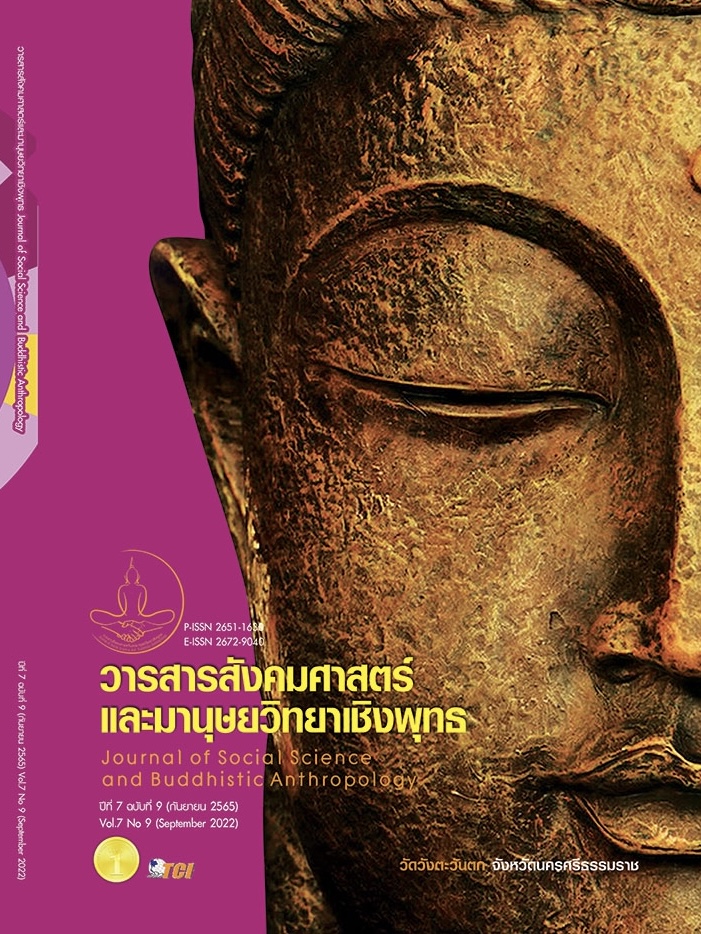CAUSAL INFLUENCE STRUCTURE FOR SUSTAINABLE GROWTH OF SMALL AND MEDIUM ENTERPRISES IN THE SOUTHERN BORDER PROVINCES
Keywords:
Causal Influence Structure, External Environment, Internal Environment, Strategic Management, Sustainable GrowthAbstract
The objectives of this research article were to 1) examine the coherence of the hypothetical model with the empirical data on the causal influence structure for the sustainable growth of small and medium-sized enterprises in the southern border provinces. 2) study direct, indirect and total effect of factors affecting the causal influence structure. A questionnaire was used as a tool to collect data from 830 participants as samples via stratified sampling and simple random sampling. Data were analyzed using structural equation modeling techniques. The results showed that 1) the developed structural equation model was consistent with the empirical data (X2/df = 1.522, IFI = 0.975, NFI = 0.930, TLI = 0.973, CFI = 0.975, GFI = 0.910, AGFI = 0.902, and RMSEA = 0.025). Therefore, the theory can be applied to explain the relationship between variables and actual phenomena of small and medium-sized enterprises in the southern border provinces. 2) The external and internal environment have a direct influence on strategic management. It was statistically significant at 0.01 and strategic management had a direct influence on sustainable growth. It was statistically significant at 0.01 level, while the external and internal environment had an indirect influence on sustainable growth statistically significant at level 0. 01. The results of this study are beneficial to small and medium enterprises entrepreneurs. The entrepreneurs must keep up with the changes in the current environment by implementing strategic management processes in the organization. At the same time, the relevant departments should provide support that is conducive to the operations of small and medium-sized enterprises, so that small and medium-sized enterprises in the southern border provinces can survive and grow sustainably.
References
กรมพัฒนาธุรกิจการค้า. (2563). สถิติข้อมูลนิติบุคคลจัดตั้งและเลิก. เรียกใช้เมื่อ 20 กรกฏาคม 2564 จาก http://www.dbd.go.th/more_news.php?cid = 1415
กัลยา วานิชย์บัญชา. (2550). สถิติสำหรับงานวิจัย. (พิมพ์ครั้งที่ 3). กรุงเทพมหานคร: จุฬาลงกรณ์มหาวิทยาลัย.
จันทร์เพ็ญ แก้วดี และคณะ. (2562). สภาพแวดล้อมภายนอก การมีส่วนร่วมและความสามารถทางการตลาดที่มีผลต่อการเติบโตของวิสาหกิจชุมชนเขตภาคเหนือตอนบน. วารสารมนุษยสังคมสาร (มสส.), 17(1), 2-48.
จิราพร ไชยศร และบุญฑวรรณ วิงวอน. (2562). บริบทของสภาพแวดล้อมและการจัดการเชิงกลยุทธ์ที่มีผลต่อการเติบโตของวิสาหกิจขนาดกลางและขนาดย่อมในจังหวัดลำปาง. วารสารสังคมศาสตร์วิชาการ, 12(2), 290-301.
ชลิตพันธ์ บุญมีสุวรรณ. (2563). นวัตกรรมและการปรับตัวของธุรกิจในยุคดิจิทัล. วารสารธุรกิจปริทัศน์, 12(2), 23–46.
เชาวลิต ประสิทธิ์ และกนกพร ชัยประสิทธิ์. (2562). ความสัมพันธ์ระหว่างปัจจัยภายนอกกับความสำเร็จของวิสาหกิจขนาดกลางและขนาดย่อมในจังหวัดฉะเชิงเทรา. วารสารการจัดการและการพัฒนา มหาวิทยาลัยราชภัฎอุบลราชธานี, 6(1), 29-56.
ตระกูล จิตวัฒนากร. (2563). ปัจจัยที่ส่งผลต่อการจัดการเชิงกลยุทธ์ของบริษัทในนิคมอุตสาหกรรมนวนคร. วารสารวิทยาลัยสงฆ์นครลำปาง, 9(2), 91-100.
ธัญญ์นิธิ จิรพัฒนาพรสิน. (2563). แนวทางการจัดการเชิงกลยุทธ์และความสามารถในการแข่งขันขององค์กรหลักฐานเชิงประจักษ์กิจการในภาคธุรกิจอุตสาหกรรมไทย. วารสารนักบริหาร, 40(2), 65-80.
ปกรณ์ อุดมธนสารสกุล. (2564). อิทธิพลของนโยบายรัฐบาลและการจัดการภาวะวิกฤตที่มีต่อกลยุทธ์การดำเนินงานของวิสาหกิจขนาดกลางและขนาดย่อม ภาคบริการในจังหวัดเชีงใหม่ ในช่วงวิกฤตของโรคระบาดโควิด 19. วารสารการบัญชีและการจัดการ มหาวิทยาลัยมหาสารคาม, 13(2),
-92.
ปัญฑารีย์ ฟองแพร่. (2559). ปัจจัยที่ส่งผลต่อการพัฒนาองค์กรให้มีศักยภาพการทำงานสูง: กรณีศึกษาธนาคารยูโอบี. ใน วิทยานิพนธ์บริหารธุรกิจมหาบัณฑิต สาขาบริหารธุรกิจ. มหาวิทยาลัยบูรพา.
พัชราพรรณ ชอบธรรม. (2562). การวางแผนกลยุทธ์: เครื่องมือสู่ความสำเร็จขององค์การ. วารสารมนุษยศาสตร์ และสังคมศาสตร์ มหาวิทยาลัยราชภัฎเชียงใหม่, 1(2), 55-75.
มลทิพย์ บำรุงกิจ และนพดล พันธุ์พานิช. (2564). การศึกษาสภาพแวดล้อมทางธุรกิจ ความเป็นผู้ประกอบการและปัจจัยกำหนด ที่มีผลต่อความได้เปรียบในการแข่งขันของเครือข่ายวิสาหกิจอุตสาหกิจอุตสาหกรรมเซรามิกส์ ลำปาง. วารสารสังคมศาสตร์และมานุษยวิทยาเชิงพุทธ, 6(2), 375-
รัตนาพร เลารุจิราลัย และคณะ. (2561). ปัจจัยสภาพแวดล้อมภายในองค์การที่มีความสัมพันธ์กับความสำเร็จในการบริหารจัดการสโมสรโรตารี่ในประเทศไทย. วารสารบัณฑิตศึกษา มหาวิทยาลัยราชภัฎเชียงราย, 11(2), 39-49.
ศักดิ์ดา ศิริภัทรโสภณ. (2563). โรคระบาดไวรัสโคโรนาสายพันธุ์ใหม่ (COVID-19): ผลกระทบต่อวิสาหกิจขนาดกลางและขนาดย่อมของไทยและกลยุทธ์ในการฟื้นฟูกิจการ. วารสารสมาคมนักวิจัย, 25(2), 9-25.
ศิริกุล ชัยโรจน์วงศ์ และชำนาญ งามมณีอุดม. (2561). ปัจจัยที่ส่งผลต่อการเติบโตของวิสาหกิจขนาดกลางและขนาดย่อมภาคการผลิตในประเทศไทย. วารสารการเมือง การบริหารและกฎหมาย, 10(2), 453-480.
สมเกียรติ อินทวงศ์. (2563). บุพปัจจัยเชิงสาเหตุที่ส่งผลต่อประสิทธิผลจากการบริหารเชิงกลยุทธ์ขององค์กรปกครองส่วนท้องถิ่นเชียงใหม่เพื่อเข้าสู่ประชาคมเศรษฐกิจอาเซียน. วารสารวิชาการสถาบันเทคโนโลยีแห่งสุวรรณภูมิ, 6(2), 522-539.
สมาคมผู้ประกอบการธุรกิจขนาดกลางและขนาดย่อมไทย. (2560). SMEsหัวใจที่แท้จริงของเศรษฐกิจไทย. เรียกใช้เมื่อ 20 มกราคม 2564 จาก http://www.tasme. or.th/aeticle/822/
สำนักข่าวกรมประชาสัมพันธ์. (2564). สำนักงานอุตสาหกรรมจังหวัดนราธิวาส สำนักงานอุตสาหกรรมจังหวัดปัตตานี และสำนักงานอุตสาหกรรมจังหวัดยะลา ร่วมกับมหาวิทยาลัยเทคโนโลยีพระจอมเกล้าพระนครเหนือ คัดเลือก 10 ผู้ประกอบการจากสามจังหวัดชายแดนใต้ เข้าร่วมกิจกรรมการส่งเสริมและพัฒนา SME เป็น smart SME และย. เรียกใช้เมื่อ 14 กรกฏาคม 2565 จาก https://thainews.prd.go.th /th/news/detail/TCATG210907091514053?fbcld=IwAR0qWYgtXSgaZ4sl4YrYVLKRqDhR9FkAMk8dTxlTvY5AaYoa8ixkrDE8iaU
สำนักส่งเสริมวิสาหกิจขนาดกลางและขนาดย่อม. (2564). Dashboard SME Big Data. เรียกใช้เมื่อ 15 มิถุนายน 2564 จาก http://www.sme.go.th/th/page.php? Modulekey=384
สุภาพร เพชรัตน์กูล และคณะ. (2564). แนวคิดเกี่ยวกับการจัดการเชิงกลยุทธ์เพื่อสร้างความเข้มแข็งให้กับชุมชน. วารสารสถาบันวิจัยและพัฒนา มหาวิทยาลัยราชภัฎมหาสารคาม, 8(2), 717-738.
Alex, A. & Bernard, A. . (2021). THE RELATIONSHIP BETWEEN STRATEGIC MANAGEMENT PRACTICESAND THE GROWTH OF SMALL AND MEDIUM ENTERPRISES (SMES) IN GHANA. Business: Theory and Practice, 22(1), 222-230.
Hair, J. F. et al. (2010). Multivariate Data Analysis (7th ed.). Pearson: New York.
Hooper, D. et al. (2008). Structural equation modelling: guidelines for determining model fit. Journal of Business Research, 6(1), 53-60.
Jöreskog, K. & Sörbom, D. (1993). LISREL 8: Structural Equation Modeling with the SIMPLIS Command Language. Chicago, IL: Scientific Software International Inc.
Kline, R. B. (2010). Principles and Practice of Structural Equation Modelling. New York: NY: TheGuilford Press.
Krejcie, R. V. & Morgan, D. W. (1970). Determining sample size for research activities. Journal of Educational and Psychological Measurement, 30(3), 607–610.
Nunnally, J. C. (1978). Psychometric Theory. (2nd ed.). New York: NY: McGraw-Hill.
Rovinelli, R. J. & Hambleton, R. K. (1977). On the Use of Content Specialists in the Assessment ofCriterion-referenced Test Item Validity, Dutch. Journal of Educational Research, 2(2), 49-60.
Downloads
Published
How to Cite
Issue
Section
License

This work is licensed under a Creative Commons Attribution-NonCommercial-NoDerivatives 4.0 International License.








